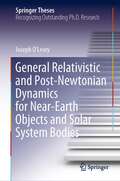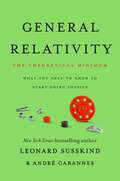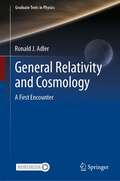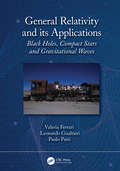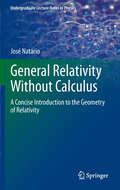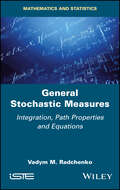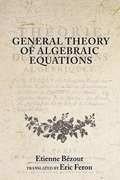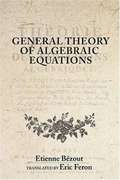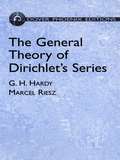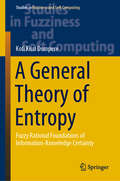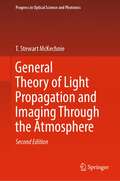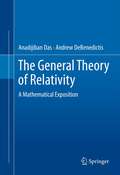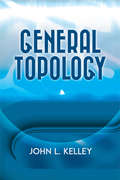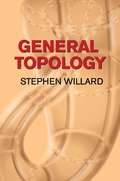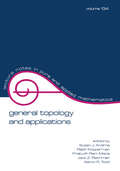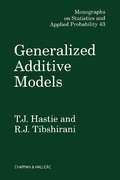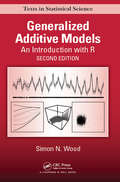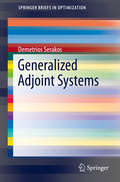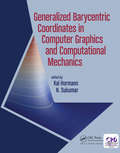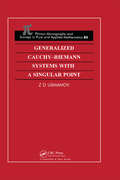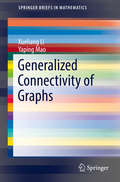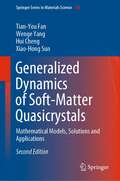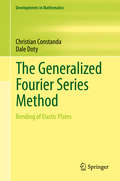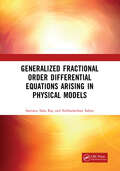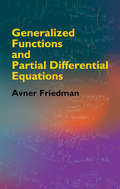- Table View
- List View
General Relativistic and Post-Newtonian Dynamics for Near-Earth Objects and Solar System Bodies (Springer Theses)
by Joseph O’LearyOwing to the increased accuracy requirements in fields such as astrometry and geodesy the general theory of relativity must be taken into account for any mission requiring highly accurate orbit information and for practically all observation and measurement techniques. This book highlights the confluence of Applied Mathematics, Physics and Space Science as seen from Einstein's general theory of relativity and aims to bridge the gap between theoretical and applied domains. The book investigates three distinct areas of general relativity: Exact solutions of the Einstein field equations of gravitation. Dynamics of near-Earth objects and solar system bodies. Relativistic orbitography. This book is an updated and expanded version of the author’s PhD thesis which was awarded the International Astronomical Union PhD prize in Division A: Fundamental Astronomy. Included is a new introduction aimed at graduate students of General Relativity and extended discussions and results on topics in post-Newtonian dynamics and general relativistic spacecraft propagation.
General Relativity: The Theoretical Minimum (The Theoretical Minimum)
by Leonard Susskind André CabannesThe latest volume in the New York Times–bestselling physics series explains Einstein&’s masterpiece: the general theory of relativity He taught us classical mechanics, quantum mechanics, and special relativity. Now, physicist Leonard Susskind, assisted by a new collaborator, André Cabannes, returns to tackle Einstein&’s general theory of relativity. Starting from the equivalence principle and covering the necessary mathematics of Riemannian spaces and tensor calculus, Susskind and Cabannes explain the link between gravity and geometry. They delve into black holes, establish Einstein field equations, and solve them to describe gravity waves. The authors provide vivid explanations that, to borrow a phrase from Einstein himself, are as simple as possible (but no simpler). An approachable yet rigorous introduction to one of the most important topics in physics, General Relativity is a must-read for anyone who wants a deeper knowledge of the universe&’s real structure.
General Relativity and Cosmology: A First Encounter (Graduate Texts in Physics)
by Ronald J. AdlerGravitational physics has now become a mainstream topic in physics and physics teaching. In particular cosmology and gravitational wave physics are at the focus of a great deal of current research. Thus it is important to introduce students to General Relativity as soon as reasonable. This textbook offers a brief but comprehensive treatment accessible to advanced undergraduate students, graduate students, and any physicist or mathematician interested in understanding the material in a short time. The author, an experienced teacher of the subject, has included numerous examples and exercises to help students consolidate the ideas they have learned.
General Relativity and its Applications: Black Holes, Compact Stars and Gravitational Waves
by Paolo Pani Valeria Ferrari Leonardo GualtieriContaining the latest, groundbreaking discoveries in the field, this text outlines the basics of Einstein’s theory of gravity with a focus on its most important astrophysical consequences, including stellar structures, black holes and the physics of gravitational waves. Blending advanced topics - usually not found in introductory textbooks - with examples, pedagogical boxes, mathematical tools and practical applications of the theory, this textbook maximises learning opportunities and is ideal for master and graduate students in Physics and Astronomy. Key features:• Provides a self-contained and consistent treatment of the subject that does not require advanced previous knowledge of the field.• Explores the subject with a new focus on gravitational waves and astrophysical relativity, unlike current introductory textbooks.• Fully up-to-date, containing the latest developments and discoveries in the field.
General Relativity Without Calculus
by Jose Natario"General Relativity Without Calculus" offers a compact but mathematically correct introduction to the general theory of relativity, assuming only a basic knowledge of high school mathematics and physics. Targeted at first year undergraduates (and advanced high school students) who wish to learn Einstein's theory beyond popular science accounts, it covers the basics of special relativity, Minkowski space-time, non-Euclidean geometry, Newtonian gravity, the Schwarzschild solution, black holes and cosmology. The quick-paced style is balanced by over 75 exercises (including full solutions), allowing readers to test and consolidate their understanding.
General Stochastic Measures: Integration, Path Properties and Equations
by Vadym M. RadchenkoThis book is devoted to the study of stochastic measures (SMs). An SM is a sigma-additive in probability random function, defined on a sigma-algebra of sets. SMs can be generated by the increments of random processes from many important classes such as square-integrable martingales and fractional Brownian motion, as well as alpha-stable processes. SMs include many well-known stochastic integrators as partial cases.General Stochastic Measures provides a comprehensive theoretical overview of SMs, including the basic properties of the integrals of real functions with respect to SMs. A number of results concerning the Besov regularity of SMs are presented, along with equations driven by SMs, types of solution approximation and the averaging principle. Integrals in the Hilbert space and symmetric integrals of random functions are also addressed.The results from this book are applicable to a wide range of stochastic processes, making it a useful reference text for researchers and postgraduate or postdoctoral students who specialize in stochastic analysis.
General Theory of Algebraic Equations
by Etienne BézoutThis book provides the first English translation of Bezout's masterpiece, the General Theory of Algebraic Equations. It follows, by almost two hundred years, the English translation of his famous mathematics textbooks. Here, Bézout presents his approach to solving systems of polynomial equations in several variables and in great detail. He introduces the revolutionary notion of the "polynomial multiplier," which greatly simplifies the problem of variable elimination by reducing it to a system of linear equations. The major result presented in this work, now known as "Bézout's theorem," is stated as follows: "The degree of the final equation resulting from an arbitrary number of complete equations containing the same number of unknowns and with arbitrary degrees is equal to the product of the exponents of the degrees of these equations." The book offers large numbers of results and insights about conditions for polynomials to share a common factor, or to share a common root. It also provides a state-of-the-art analysis of the theories of integration and differentiation of functions in the late eighteenth century, as well as one of the first uses of determinants to solve systems of linear equations. Polynomial multiplier methods have become, today, one of the most promising approaches to solving complex systems of polynomial equations or inequalities, and this translation offers a valuable historic perspective on this active research field.
General Theory of Algebraic Equations
by Etienne ÉzoutThis book provides the first English translation of Bezout's masterpiece, the General Theory of Algebraic Equations. It follows, by almost two hundred years, the English translation of his famous mathematics textbooks. Here, Bézout presents his approach to solving systems of polynomial equations in several variables and in great detail. He introduces the revolutionary notion of the "polynomial multiplier," which greatly simplifies the problem of variable elimination by reducing it to a system of linear equations. The major result presented in this work, now known as "Bézout's theorem," is stated as follows: "The degree of the final equation resulting from an arbitrary number of complete equations containing the same number of unknowns and with arbitrary degrees is equal to the product of the exponents of the degrees of these equations." The book offers large numbers of results and insights about conditions for polynomials to share a common factor, or to share a common root. It also provides a state-of-the-art analysis of the theories of integration and differentiation of functions in the late eighteenth century, as well as one of the first uses of determinants to solve systems of linear equations. Polynomial multiplier methods have become, today, one of the most promising approaches to solving complex systems of polynomial equations or inequalities, and this translation offers a valuable historic perspective on this active research field.
The General Theory of Dirichlet's Series (Dover Books on Mathematics)
by G. H. Hardy Marcel RieszThis classic work explains the theory and formulas behind Dirichlet's series and offers the first systematic account of Riesz's theory of the summation of series by typical means. Its authors rank among the most distinguished mathematicians of the twentieth century: G. H. Hardy is famous for his achievements in number theory and mathematical analysis, and Marcel Riesz's interests ranged from functional analysis to partial differential equations, mathematical physics, number theory, and algebra.Following an introduction, the authors proceed to a discussion of the elementary theory of the convergence of Dirichlet's series, followed by a look at the formula for the sum of the coefficients of a Dirichlet's series in terms of the order of the function represented by the series. They continue with an examination of the summation of series by typical means and of general arithmetic theorems concerning typical means. After a survey of Abelian and Tauberian theorems and of further developments of the theory of functions represented by Dirichlet's series, the text concludes with an exploration of the multiplication of Dirichlet's series.
A General Theory of Entropy: Fuzzy Rational Foundations of Information-Knowledge Certainty (Studies in Fuzziness and Soft Computing #384)
by Kofi Kissi DompereThis book presents an epistemic framework for dealing with information-knowledge and certainty-uncertainty problems within the space of quality-quantity dualities. It bridges between theoretical concepts of entropy and entropy measurements, proposing the concept and measurement of fuzzy-stochastic entropy that is applicable to all areas of knowing under human cognitive limitations over the epistemological space. The book builds on two previous monographs by the same author concerning theories of info-statics and info-dynamics, to deal with identification and transformation problems respectively. The theoretical framework is developed by using the toolboxes such as those of the principle of opposites, systems of actual-potential polarities and negative-positive dualities, under different cost-benefit time-structures. The category theory and the fuzzy paradigm of thought, under methodological constructionism-reductionism duality, are used in the fuzzy-stochastic and cost-benefit spaces to point to directions of global application in knowing, knowledge and decision-choice actions. Thus, the book is concerned with a general theory of entropy, showing how the fuzzy paradigm of thought is developed to deal with the problems of qualitative-quantitative uncertainties over the fuzzy-stochastic space, which will be applicable to conditions of soft-hard data, fact, evidence and knowledge over the spaces of problem-solution dualities, decision-choice actions in sciences, non-sciences, engineering and planning sciences to abstract acceptable information-knowledge elements.
General Theory of Light Propagation and Imaging Through the Atmosphere (Progress in Optical Science and Photonics #20)
by T. Stewart McKechnieThis 2nd edition lays out an updated version of the general theory of light propagation and imaging through Earth’s turbulent atmosphere initially developed in the late ‘70s and ‘80s, with additional applications in the areas of laser communications and high-energy laser beam propagation. New material includes a chapter providing a comprehensive mathematical tool set for precisely characterizing image formation with the anticipated Extremely Large Telescopes (ELTS), enabling a staggering range of star image shapes and sizes; existing chapters rewritten or modified so as to supplement the mathematics with clearer physical insight through written and graphical means; a history of the development of present-day understanding of light propagation and imaging through the atmosphere as represented by the general theory described. Beginning with the rudimentary, geometrical-optics based understanding of a century ago, it describes advances made in the 1960s, including the development of the ‘Kolmogorov theory,’ the deficiencies of which undermined its credibility, but not before it had done enormous damage, such as construction of a generation of underperforming ‘light bucket’ telescopes. The general theory requires no a priori turbulence assumptions. Instead, it provides means for calculating the turbulence properties directly from readily-measurable properties of star images.
The General Theory of Relativity
by Andrew Debenedictis Anadijiban DasThe General Theory of Relativity: A Mathematical Exposition will serve readers as a modern mathematical introduction to the general theory of relativity. Throughout the book, examples, worked-out problems, and exercises (with hints and solutions) are furnished. Topics in this book include, but are not limited to: tensor analysis the special theory of relativity the general theory of relativity and Einstein's field equations spherically symmetric solutions and experimental confirmations static and stationary space-time domains black holes cosmological models algebraic classifications and the Newman-Penrose equations the coupled Einstein-Maxwell-Klein-Gordon equations appendices covering mathematical supplements and special topics Mathematical rigor, yet very clear presentation of the topics make this book a unique text for both university students and research scholars. Anadijiban Das has taught courses on Relativity Theory at The University College of Dublin, Ireland, Jadavpur University, India, Carnegie-Mellon University, USA, and Simon Fraser University, Canada. His major areas of research include, among diverse topics, the mathematical aspects of general relativity theory. Andrew DeBenedictis has taught courses in Theoretical Physics at Simon Fraser University, Canada, and is also a member of The Pacific Institute for the Mathematical Sciences. His research interests include quantum gravity, classical gravity, and semi-classical gravity.
General Topology (Dover Books on Mathematics)
by John L. Kelley"The clarity of the author's thought and the carefulness of his exposition make reading this book a pleasure," noted the Bulletin of the American Mathematical Society upon the 1955 publication of John L. Kelley's General Topology. This comprehensive treatment for beginning graduate-level students immediately found a significant audience, and it remains a highly worthwhile and relevant book for students of topology and for professionals in many areas. A systematic exposition of the part of general topology that has proven useful in several branches of mathematics, this volume is especially intended as background for modern analysis. An extensive preliminary chapter presents mathematical foundations for the main text. Subsequent chapters explore topological spaces, the Moore-Smith convergence, product and quotient spaces, embedding and metrization, and compact, uniform, and function spaces. Each chapter concludes with an abundance of problems, which form integral parts of the discussion as well as reinforcements and counter examples that mark the boundaries of possible theorems. The book concludes with an extensive index that provides supplementary material on elementary set theory.
General Topology
by Stephen WillardAmong the best available reference introductions to general topology, this volume is appropriate for advanced undergraduate and beginning graduate students. Its treatment encompasses two broad areas of topology: "continuous topology," represented by sections on convergence, compactness, metrization and complete metric spaces, uniform spaces, and function spaces; and "geometric topology," covered by nine sections on connectivity properties, topological characterization theorems, and homotopy theory. Many standard spaces are introduced in the related problems that accompany each section (340 exercises in all). The text's value as a reference work is enhanced by a collection of historical notes, a bibliography, and index. 1970 edition. 27 figures.
General Topology and Applications: Fifth Northeast Conference (Annals Of The New York Academy Of Sciences Ser. #Vol. 659)
by Susan J. AndimaThis book is based on the proceedings of the Fifth Northeast Conference on General Topology and Applications, held at The College of Staten Island – The City University of New York. It provides insight into the relationship between general topology and other areas of mathematics.
Generalized Additive Models
by T.J. HastieThis book describes an array of power tools for data analysis that are based on nonparametric regression and smoothing techniques. These methods relax the linear assumption of many standard models and allow analysts to uncover structure in the data that might otherwise have been missed. While McCullagh and Nelder's Generalized Linear Models shows how to extend the usual linear methodology to cover analysis of a range of data types, Generalized Additive Models enhances this methodology even further by incorporating the flexibility of nonparametric regression. Clear prose, exercises in each chapter, and case studies enhance this popular text.
Generalized Additive Models: An Introduction with R, Second Edition (Chapman & Hall/CRC Texts in Statistical Science)
by Simon N. WoodThe first edition of this book has established itself as one of the leading references on generalized additive models (GAMs), and the only book on the topic to be introductory in nature with a wealth of practical examples and software implementation. It is self-contained, providing the necessary background in linear models, linear mixed models, and generalized linear models (GLMs), before presenting a balanced treatment of the theory and applications of GAMs and related models. The author bases his approach on a framework of penalized regression splines, and while firmly focused on the practical aspects of GAMs, discussions include fairly full explanations of the theory underlying the methods. Use of R software helps explain the theory and illustrates the practical application of the methodology. Each chapter contains an extensive set of exercises, with solutions in an appendix or in the book’s R data package gamair, to enable use as a course text or for self-study.
Generalized Adjoint Systems
by Demetrios SerakosThis book defines and develops the generalized adjoint of an input-output system. It is the result of a theoretical development and examination of the generalized adjoint concept and the conditions under which systems analysis using adjoints is valid. Results developed in this book are useful aids for the analysis and modeling of physical systems, including the development of guidance and control algorithms and in developing simulations. The generalized adjoint system is defined and is patterned similarly to adjoints of bounded linear transformations. Next the elementary properties of the generalized adjoint system are derived. For a space of input-output systems, a generalized adjoint map from this space of systems to the space of generalized adjoints is defined. Then properties of the generalized adjoint map are derived. Afterward the author demonstrates that the inverse of an input-output system may be represented in terms of the generalized adjoint. The use of generalized adjoints to determine bounds for undesired inputs such as noise and disturbance to an input-output system is presented and methods which parallel adjoints in linear systems theory are utilized. Finally, an illustrative example is presented which utilizes an integral operator representation for the system mapping.
Generalized Barycentric Coordinates in Computer Graphics and Computational Mechanics
by Kai Hormann N. SukumarIn Generalized Barycentric Coordinates in Computer Graphics and Computational Mechanics, eminent computer graphics and computational mechanics researchers provide a state-of-the-art overview of generalized barycentric coordinates. Commonly used in cutting-edge applications such as mesh parametrization, image warping, mesh deformation, and finite as well as boundary element methods, the theory of barycentric coordinates is also fundamental for use in animation and in simulating the deformation of solid continua. Generalized Barycentric Coordinates is divided into three sections, with five chapters each, covering the theoretical background, as well as their use in computer graphics and computational mechanics. A vivid 16-page insert helps illustrating the stunning applications of this fascinating research area. <P><P>Key Features: <li>Provides an overview of the many different types of barycentric coordinates and their properties. <li>Discusses diverse applications of barycentric coordinates in computer graphics and computational mechanics. <li>The first book-length treatment on this topic
Generalized Cauchy-Riemann Systems with a Singular Point
by Zafar D UsmanovA theory of generalized Cauchy-Riemann systems with polar singularities of order not less than one is presented and its application to study of infinitesimal bending of surfaces having positive curvature and an isolated flat point is given. The book contains results of investigations obtained by the author and his collaborators.
Generalized Connectivity of Graphs
by Xueliang Li Yaping MaoNoteworthy results, proof techniques, open problems and conjectures in generalized (edge-) connectivity are discussed in this book. Both theoretical and practical analyses for generalized (edge-) connectivity of graphs are provided. Topics covered in this book include: generalized (edge-) connectivity of graph classes, algorithms, computational complexity, sharp bounds, Nordhaus-Gaddum-type results, maximum generalized local connectivity, extremal problems, random graphs, multigraphs, relations with the Steiner tree packing problem and generalizations of connectivity. This book enables graduate students to understand and master a segment of graph theory and combinatorial optimization. Researchers in graph theory, combinatorics, combinatorial optimization, probability, computer science, discrete algorithms, complexity analysis, network design, and the information transferring models will find this book useful in their studies.
Generalized Dynamics of Soft-Matter Quasicrystals: Mathematical Models, Solutions and Applications (Springer Series in Materials Science #260)
by Tian-You Fan Wenge Yang Hui Cheng Xiao-Hong SunThis book highlights the mathematical models and solutions of the generalized dynamics of soft-matter quasicrystals (SMQ) and introduces possible applications of the theory and methods. Based on the theory of quasiperiodic symmetry and symmetry breaking, the book treats the dynamics of individual quasicrystal systems by reducing them to nonlinear partial differential equations and then provides methods for solving the initial-boundary value problems in these equations. The solutions obtained demonstrate the distribution, deformation and motion of SMQ and determine the stress, velocity and displacement fields. The interactions between phonons, phasons and fluid phonons are discussed in some fundamental materials samples. The reader benefits from a detailed comparison of the mathematical solutions for both solid and soft-matter quasicrystals, gaining a deeper understanding of the universal properties of SMQ. The second edition covers the latest research progress on quasicrystals in topics such as thermodynamic stability, three-dimensional problems and solutions, rupture theory, and the photonic band-gap and its applications. These novel chapters make the book an even more useful and comprehensive reference guide for researchers in condensed matter physics, chemistry and materials sciences.
The Generalized Fourier Series Method: Bending of Elastic Plates (Developments in Mathematics #65)
by Christian Constanda Dale DotyThis book explains in detail the generalized Fourier series technique for the approximate solution of a mathematical model governed by a linear elliptic partial differential equation or system with constant coefficients. The power, sophistication, and adaptability of the method are illustrated in application to the theory of plates with transverse shear deformation, chosen because of its complexity and special features. In a clear and accessible style, the authors show how the building blocks of the method are developed, and comment on the advantages of this procedure over other numerical approaches. An extensive discussion of the computational algorithms is presented, which encompasses their structure, operation, and accuracy in relation to several appropriately selected examples of classical boundary value problems in both finite and infinite domains. The systematic description of the technique, complemented by explanations of the use of the underlying software, will help the readers create their own codes to find approximate solutions to other similar models. The work is aimed at a diverse readership, including advanced undergraduates, graduate students, general scientific researchers, and engineers.The book strikes a good balance between the theoretical results and the use of appropriate numerical applications. The first chapter gives a detailed presentation of the differential equations of the mathematical model, and of the associated boundary value problems with Dirichlet, Neumann, and Robin conditions. The second chapter presents the fundamentals of generalized Fourier series, and some appropriate techniques for orthonormalizing a complete set of functions in a Hilbert space. Each of the remaining six chapters deals with one of the combinations of domain-type (interior or exterior) and nature of the prescribed conditions on the boundary. The appendices are designed to give insight into some of the computational issues that arise from the use of the numerical methods described in the book.Readers may also want to reference the authors’ other books Mathematical Methods for Elastic Plates, ISBN: 978-1-4471-6433-3 and Boundary Integral Equation Methods and Numerical Solutions: Thin Plates on an Elastic Foundation, ISBN: 978-3-319-26307-6.
Generalized Fractional Order Differential Equations Arising in Physical Models
by Santanu Ray Subhadarshan SahooThis book analyzes the various semi-analytical and analytical methods for finding approximate and exact solutions of fractional order partial differential equations. It explores approximate and exact solutions obtained by various analytical methods for fractional order partial differential equations arising in physical models.
Generalized Functions and Partial Differential Equations (Dover Books on Mathematics)
by Avner FriedmanThis self-contained treatment develops the theory of generalized functions and the theory of distributions, and it systematically applies them to solving a variety of problems in partial differential equations. A major portion of the text is based on material included in the books of L. Schwartz, who developed the theory of distributions, and in the books of Gelfand and Shilov, who deal with generalized functions of any class and their use in solving the Cauchy problem. In addition, the author provides applications developed through his own research.Geared toward upper-level undergraduates and graduate students, the text assumes a sound knowledge of both real and complex variables. Familiarity with the basic theory of functional analysis, especially normed spaces, is helpful but not necessary. An introductory chapter features helpful background on topological spaces. Applications to partial differential equations include a treatment of the Cauchy problem, the Goursat problem, fundamental solutions, existence and differentiality of solutions of equations with constants, coefficients, and related topics. Supplementary materials include end-of-chapter problems, bibliographical remarks, and a bibliography.
